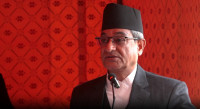National
Mismatch in PM Dahal’s assets raises eyebrows
It is clear that either he lied in 2016 or he is lying now, says Transparency International Nepal ex-chair Khem Raj Regmi.
Binod Ghimire
Making public his property details after becoming prime minister for the second time in December 2016, Pushpa Kamal Dahal, who also is the CPN (Maoist Centre) chair, had announced his family owns just a small piece of land and a few grams of gold.
In the details Dahal had claimed he did not have any property in his name raising many eyebrows. His only property was one kattha (338.57 square metres) of ancestral land in Chitwan and three tola (1 tola is 11.66 grams) of gold, both owned by his spouse Sita Dahal. Ancestral inheritance was the source he had mentioned for the land and gold.
Just a few days later after making his property details public, he had vented his frustration over allegations that he owns multi-storey buildings and is very rich, and asserted that the reality was quite different as revealed in his property disclosure. “When we brothers received our shares of parental property, I got a bigha and a half [1.02 hectares] of land. I sold it all and donated the cash to the party,” Dahal had claimed in the press meet held on December 17, 2016 in Bharatpur, his home district.
Seven years later, on Tuesday, Dahal made public his property details again, showing he owns land several times more than what he had declared in 2016. As per the details, he has two plots of land totalling 15 kattha [0.5 hectares] and a building in Bharatpur, Chitwan registered in the name of his deceased wife. He claims that the land is ancestral.
However, the details are contradictory. Dahal, who in 2016 had claimed that he had sold all the parental land, said that the land currently in his possession is an inheritance. “It is clear that either he lied in 2016 or he is lying now. Both the details cannot be true,” retired secretary Khem Raj Remi, who also is a former chair of Transparency International Nepal, told the Post. “He must clarify this to the people.”
Regmi said not many people were sceptical of Dahal’s property details in 2016. At that time he claimed that he had sold all his land and donated the money to the party. “If he sold his parental land, what is the source of the land he possesses now?” said Regmi.
The land with the house in Bharatpur came to light just a couple of months before the November 2022 elections. Dahal claimed he had built the house in his home district as he wanted to spend more time with the people from his constituency. But he didn’t contest the elections from Chitwan and shifted to Gorkha.
Dahal’s aides say they cannot explain the discrepancy in the property details. “I have no idea about it. I need to inquire before giving details,” Ramesh Malla, personal secretary to the prime minister, told the Post.
Despite suspecting the accuracy of the property details, activists advocating for transparency have commended the Dahal government for resuming the practice of making property details public.
The first elected government after the restoration of democracy in 1990 started the practice of making public the property details of the prime minister and ministers.
The tradition started by then prime minister Girija Prasad Koirala’s cabinet continued until 2018. Except for Khil Raj Regmi and his team, all prime ministers and ministers up to the second KP Sharma Oli government made their property details public.
However, the Sher Bahadur Deuba government which succeeded Oli broke the tradition. Deuba and his ministers didn’t make their property details public despite being in power for a year and a half.
Dahal also waited for a year and half to make his property details. It was under pressure from the ministers of the Rastriya Swatantra Party that Dahal was forced to make the details public.
The Corruption Prevention Act, 2002 requires prime ministers and ministers to submit their property details within 60 days of joining the government while all public position holders need to submit the details within 60 days after the end of each fiscal year. In addition to the prime minister and ministers, the rule applies to all elected representatives and government employees.
Although the Act doesn’t make it mandatory to unveil the property details, successive prime ministers and ministers made them public as a sign of their commitment to transparency. The details were made public after their submission to the Council of Ministers.




 10.12°C Kathmandu
10.12°C Kathmandu















